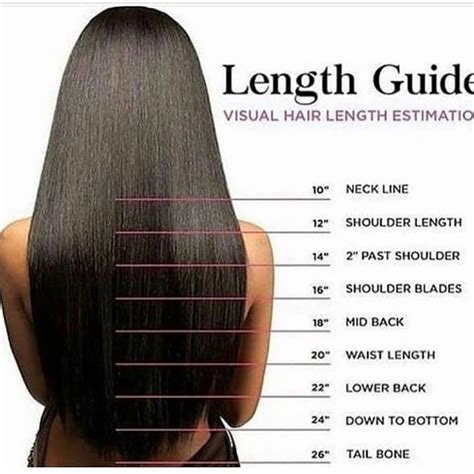Measuring hair growth is essential for tracking progress with hair care routines and making informed decisions about hair care choices. A hair inch chart provides a visual representation of hair length, making it easier to monitor hair growth over time. This comprehensive guide will provide you with an in-depth understanding of hair growth and how to use a hair inch chart to track your progress.

Understanding Hair Growth
Hair grows from the root, which is located under the skin. The root is made up of a hair follicle, which produces the hair shaft. The hair shaft is the visible part of the hair that extends above the scalp. Hair grows in cycles, with each cycle consisting of three phases:
- Anagen phase: This is the active growth phase, which lasts for 2-6 years. During this phase, the hair follicle produces new hair shafts.
- Catagen phase: This is a transitional phase, which lasts for 2-3 weeks. During this phase, the hair follicle shrinks and the hair shaft is pushed out of the scalp.
- Telogen phase: This is the resting phase, which lasts for 3-4 months. During this phase, the hair follicle is dormant and the hair shaft is shed.
The Hair Inch Chart
A hair inch chart is a ruler that is used to measure the length of hair. The chart typically has markings for each inch of hair growth, allowing you to easily track your progress. Hair inch charts can be purchased online or at beauty supply stores.
How to Use a Hair Inch Chart
To use a hair inch chart, simply place the chart against your scalp and measure the length of your hair from the root to the tip. Be sure to measure your hair when it is dry and straight. Record your measurements on the chart and track your progress over time.
Benefits of Using a Hair Inch Chart
There are several benefits to using a hair inch chart:
- Track hair growth: A hair inch chart allows you to track your hair growth over time, which can help you to assess the effectiveness of your hair care routine.
- Identify hair loss: If you notice that your hair is not growing as quickly as it used to, a hair inch chart can help you to identify hair loss sooner rather than later.
- Set hair care goals: A hair inch chart can help you to set hair care goals and track your progress towards achieving them.
- Make informed hair care decisions: A hair inch chart can help you to make informed hair care decisions, such as when to get a haircut or when to start using a new hair care product.
Common Pain Points in Measuring Hair Growth
Measuring Hair Growth: Motivations and Benefits
Accuracy and Precision
Why Does It Matter?
Potential Applications
Hair Inch Chart Table 1. Common Hair Growth Rates
| Hair Type | Average Growth Rate (inches per month) |
|---|---|
| Straight hair | 0.5-1.0 |
| Wavy hair | 0.75-1.25 |
| Curly hair | 1.0-1.5 |
Hair Inch Chart Table 2. Factors Affecting Hair Growth
| Factor | Effect on Hair Growth |
|---|---|
| Genetics | Determines the maximum length and thickness of hair |
| Nutrition | A healthy diet can promote hair growth |
| Stress | Stress can slow down hair growth |
| Hormonal changes | Pregnancy, menopause, and thyroid problems can affect hair growth |
| Hair care routine | Gentle hair care practices can promote hair growth |
Hair Inch Chart Table 3. Pros and Cons of Using a Hair Inch Chart
| Pros | Cons |
|---|---|
| Easy to use | Not always accurate |
| Inexpensive | Can be time-consuming |
| Can track hair growth over time | May not be suitable for all hair types |
Conclusion
A hair inch chart is a valuable tool for measuring hair growth and tracking progress with hair care routines. By understanding hair growth and the benefits of using a hair inch chart, you can make informed decisions about your hair care and achieve your desired hair length.
